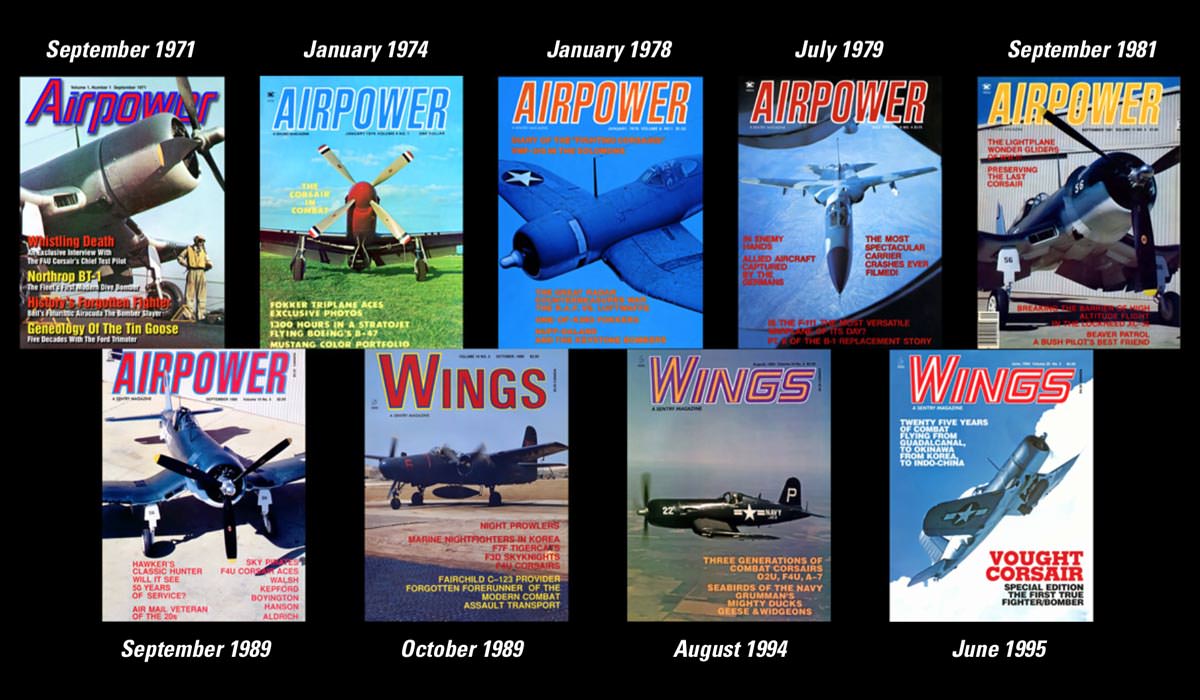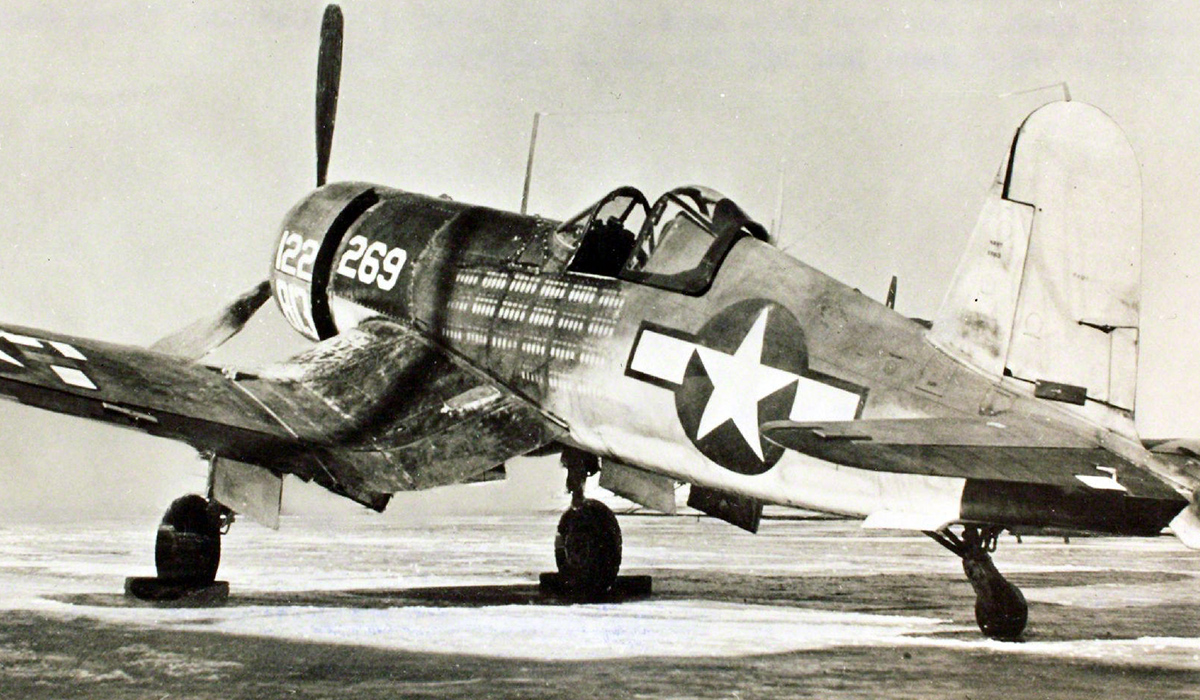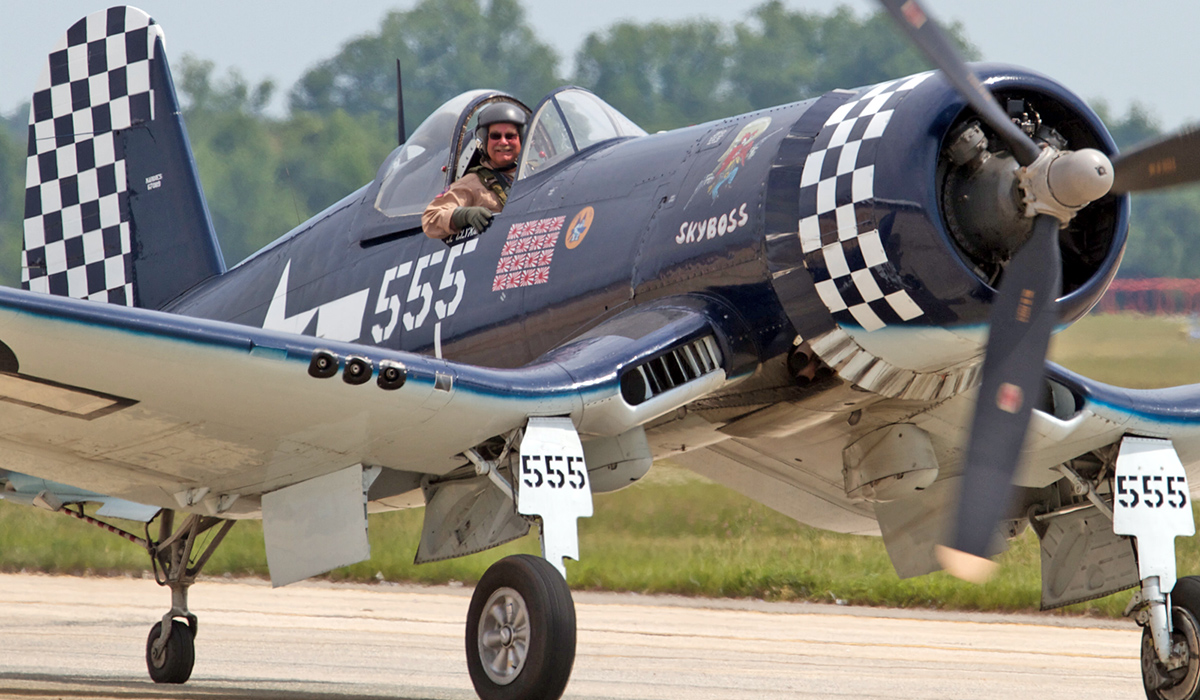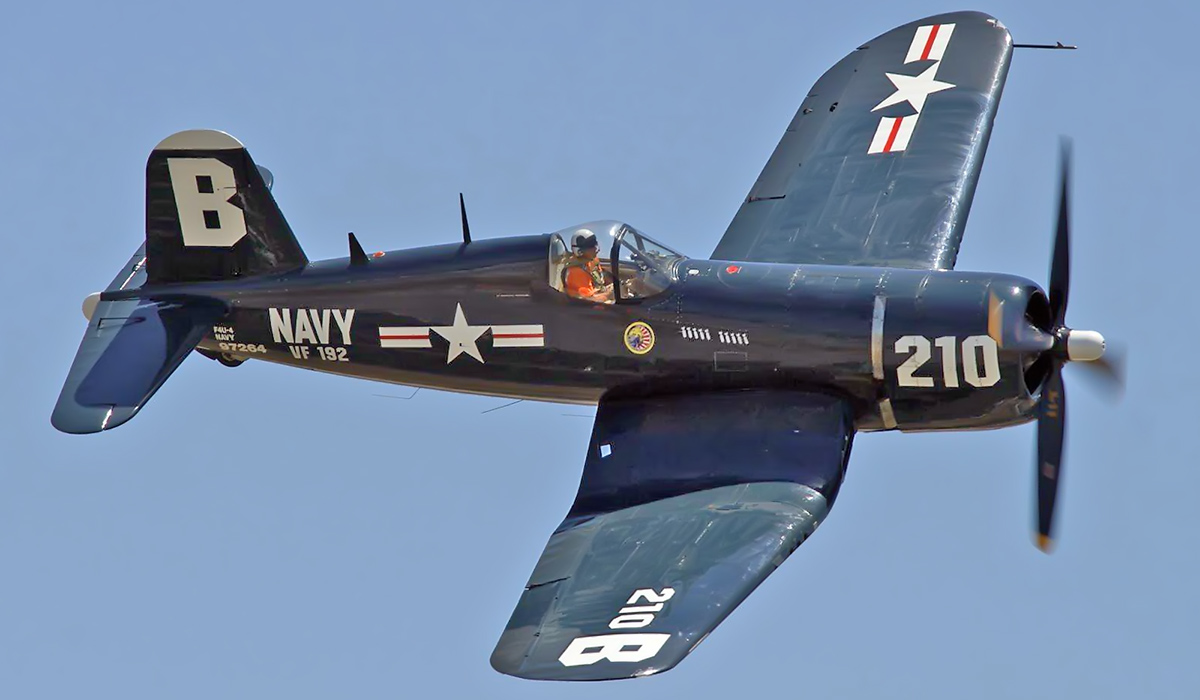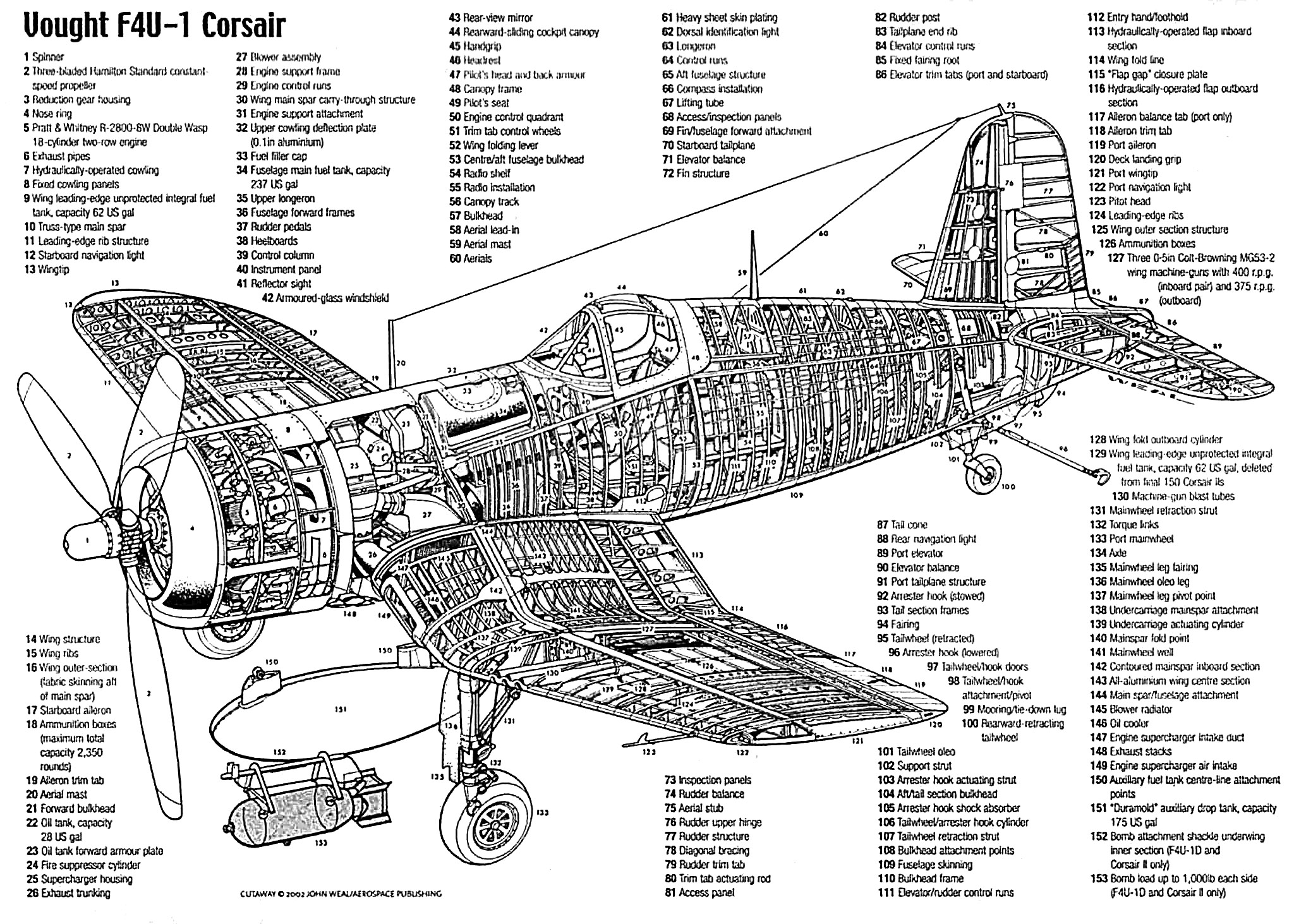Price: $44.95
- 9 magazines, 15 manuals, & photos
- PDF contains 2,518 pages
- Content is keyword searchable
- Print a personal copy
- Pay via PayPal or Credit Card
- International orders welcome!
- Download files upon payment
September 1971
- Old Hog Nose, veteran pilot rates the F4U Corsair
- Ford had a better deal, four decades with the “Tin Goose”
- Bomber One, BT-1 the fleet’s first modern diver bomber
- Sky Tiger, Bell’s Airacuda… bomber destroyer without a mission
January 1974
- The Ultimate Corsairs, F4Us in the Pacific and Korea
- Stratojet, flying the Queen of the Strategic Air Command
- Skymaster, continuing the DC legend with the first of America’s superliners
- Tri-Winged Terror, a Galaxy of Fokker triplane aces
January 1978
- Sweathogs of the Solomons, a Marine F4U Corsair combat pilot’s diary
- The Radar War, Luftwaffe stalks the R.A.F.
- The Forgotten Fokkers, fabulous firsts and forlorn flops
- Huff-Daland in 3D, from dusters to keystone bombers
July 1979
- Welcome Aboard! Carrier crackups, crunches, and catastrophes
- On Foreign Fields, captured allied aircraft
- F-111 Billion Dollar Blunder
- Mustang Milestones, pictorial evolution of the P-51
September 1981
- The Last Corsair, restoring an F4U for the ages
- The Nine Day Wonders, America’s WWII glider training fleet
- Crossing the High Frontier, Lockheed’s XC-35
- “Leave It To Beaver”, a rugged bush plane joins the service
September 1989
- Pirate of the Pacific, the Vought F4U Corsair
- Hawker Hunter, world’s longest lived combat airplane
- Carrier Pigeon, Curtiss delivers the mail
October 1989
- Wait Until Dark, night combat missions over North Korea
- Payload! The Fairchild C-123
August 1994
- 3rd Generation Corsairs, 60 years of close air support
- Grumman’s Seabirds, airborne amphibians: Goose, Duck, Mallard
June 1995
- Corsair, story of Vought’s revolutionary Navy fighter
Manuals & Photos
- F2G-1 Pilot’s Handbook, 1945
- F4U I-IV Pilot’s Notes, 1944
- F4U Pilot’s Manual, 1977
- F4U-1 Erection Maintenance, 1942
- F4U-1 Operating Instructions, 1944
- F4U-1 Pilot’s Handbook, 1944
- F4U-1 Structural Repair Instructions, 1944
- F4U-4 Assembly Breakdown, 1944
- F4U-4 Pilot’s Handbook, 1944
- F4U-4 Pilot’s Handbook, 1946
- F4U-4/4B Pilot’s Handbook, 1952
- F4U-5 Erection Maintenance, 1948
- F4U-5 Information Manual, 1948
- F4U-5 Pilot’s Handbook, 1951
- F4U-5/5N Maintenance Parts List, 1951
- Over 550 F4U Corsair photos
Vought F4U Corsair
F4U-1A Specs
F4U-4 Specs
Variants
On Display
Cutaway
General Characteristics
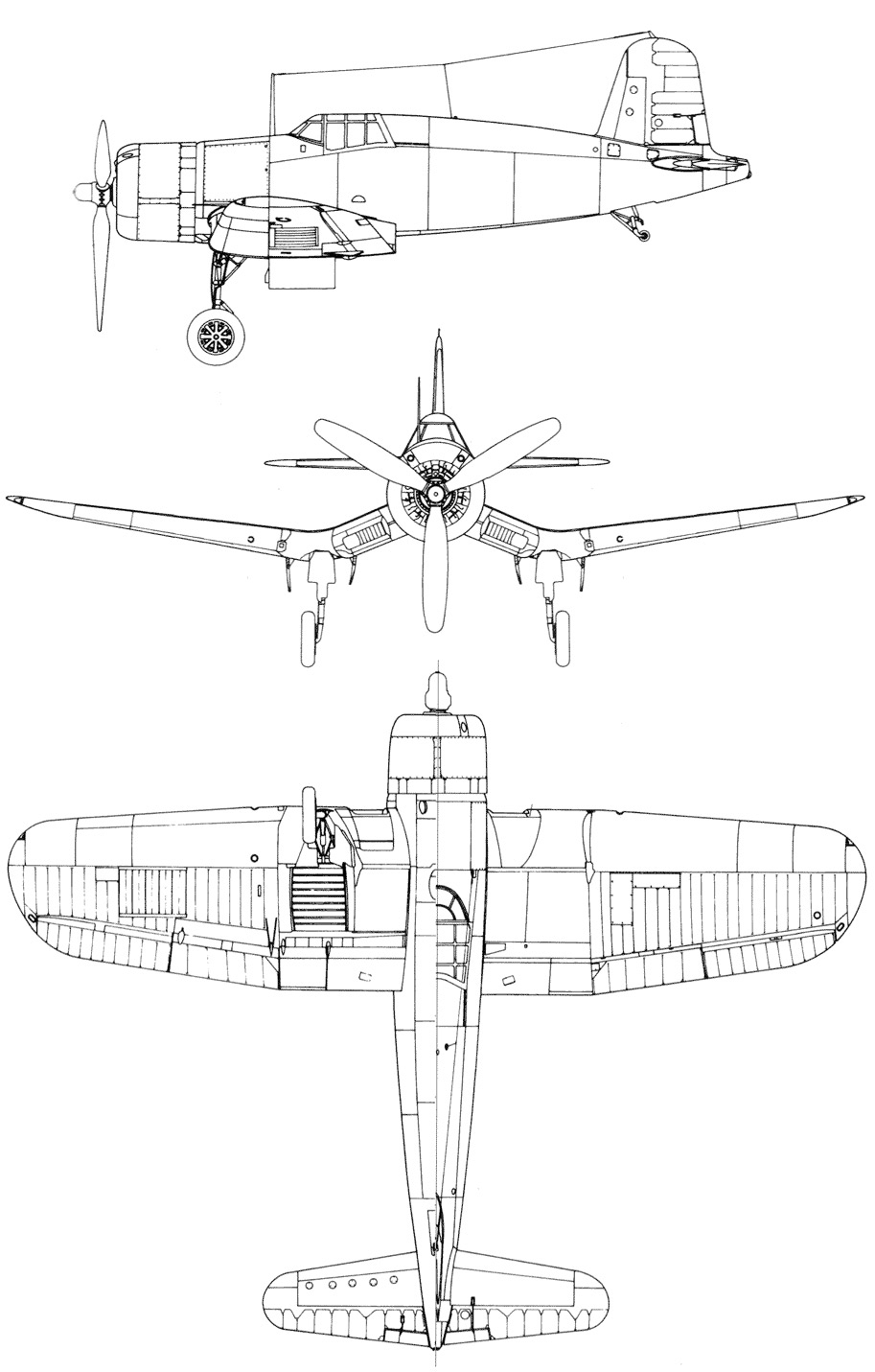
- Crew: 1 pilot
- Length: 33 ft 4 in (10.1 m)
- Wingspan: 41 ft 0 in (12.5 m)
- Height: 16 ft 1 in (4.90 m)
- Wing area: 314 ft2 (29.17 m2)
- Empty weight: 8,982 lb (4,073 kg)
- Loaded weight: 11,432 lb (5,185 kg)
- Powerplant: 1 × Pratt & Whitney R-2800-8 radial engine, 2,000 hp (1,491 kW)
Performance
- Maximum speed: 417 mph (362 kn, 671 km/h)
- Range: 1,015 mi (882 nmi (1,633 km))
- Service ceiling: 36,900 ft (11,247 m)
- Rate of climb: 2,890 ft/min (15.2 m/s)
Armament
- Guns:
- 4 × 0.50 in (12.7 mm) AN/M2 Browning machine guns, 400 rounds per gun
- 2 × 0.50 in AN/M2 Browning machine guns, 375 rounds per gun
- Rockets: 4 × 5 in (12.7 cm) High Velocity Aircraft Rockets and/or
- Bombs: 2,000 pounds (910 kg)
General Characteristics
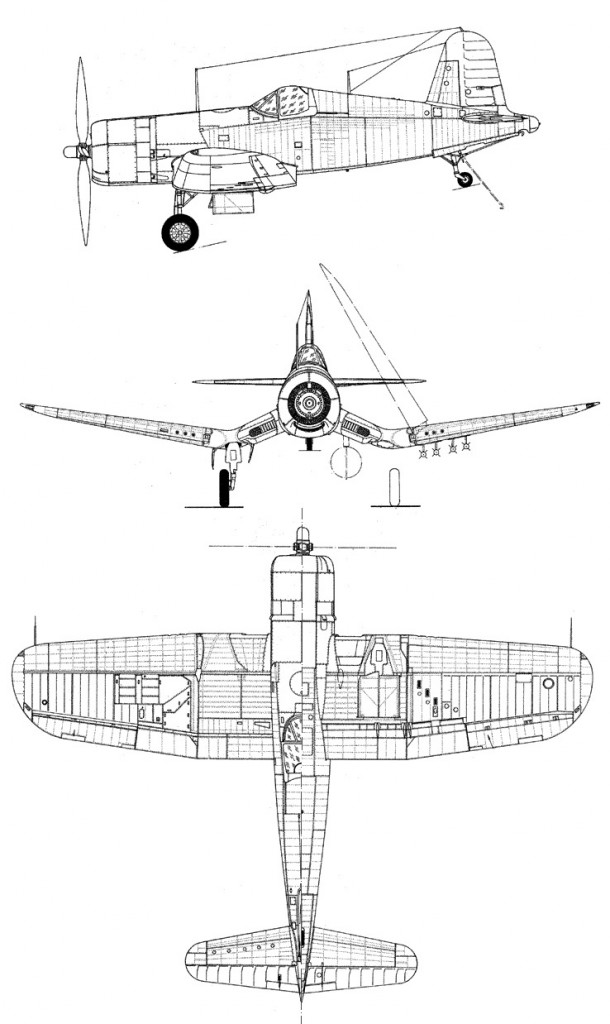
- Crew: 1 pilot
- Length: 33 ft 8 in (10.2 m)
- Wingspan: 41 ft 0 in (12.5 m)
- WS Folded: 17 ft 0.5 in (5.2 m)
- Height: 14 ft 9 in (4.50 m)
- Empty weight: 9,205 lb (4,174 kg)
- Loaded weight: 12,405 lb (5,626 kg)
- Powerplant: 1 × Pratt & Whitney R-2800-18W radial engine, 2,325 hp (1,710 kW)
Performance
- Maximum speed: 453 mph (395 kn, 731 km/h)
- Range: 897 mi (602 nmi (1,115 km))
- Service ceiling: 41,500ft (12,649 m)
- Rate of climb: 3,870ft/min (19.7 m/s)
Armament
- Guns:
- 6 × 0.50 in (12.7 mm) AN/M2 Browning machine guns, 400 rounds per gun or
- 4 × 0.79 in (20 mm) M2 cannon
- Rockets: 8 × 5 in (12.7 cm) high velocity aircraft rockets and/or
- Bombs: 4,000 pounds (1,800 kg)
F4U-1 (called Corsair Mk I by the Fleet Air Arm ):
The first production version of the Corsair with the distinctive “birdcage” canopy and low seating position. The differences over the XF4U-1 were as follows:
- Six .50 in (12.7 mm) Browning AN/M2 machine guns were fitted in the outer wing panels, displacing fuel tanks.
- An enlarged 237 gal (897 l) fuel tank was fitted ahead of the cockpit, in place of the fuselage armament. The cockpit was moved back by 32 in (810 mm).
- The fuselage was lengthened by 1 ft 5 in (0.43 m).
- The more powerful R-2800-8 Double Wasp was fitted.
- 150 pounds (68 kg) of armor plate was fitted to the cockpit and a 1.5 in (38 mm) thick bullet-resistant glass panel was fitted behind the curved windscreen.
- IFF transponder equipment was fitted.
- Curved transparent panels were incorporated into the fuselage behind the pilot’s headrest.
- The flaps were changed from deflector type to NACA slotted.
- The span of the ailerons was increased while that of the flaps was decreased.
- One 62 gal (234 l) auxiliary fuel cell (not a self-sealing type) was installed in each wing leading edge, just outboard of the guns.
The Royal Navy’s Fleet Air Arm received 95 Vought F4U-1s. These were all early “birdcage” Corsairs. Vought also built a single F4U-1 two-seat trainer; the Navy showed no interest.
F4U-1A (called Corsair Mk II by the Fleet Air Arm ):
Mid-to-late production Corsairs incorporated a new, taller, wider canopy with only two frames — very close to what the Malcolm hood did for British fighter aircraft — along with a simplified windscreen; the new canopy design meant that the semi-elliptical turtledeck “flank” windows could be omitted. The designation F4U-1A to differentiate these Corsairs from earlier “birdcage” variants was allowed to be used internally by manufacturers The pilot’s seat was raised 7 in (180 mm) which, combined with the new canopy and a 6-inch (152.4 mm) lengthening of the tailwheel strut, allowed the pilot better visibility over the long nose. In addition to these changes, the bombing window under the cockpit was omitted. These Corsairs introduced a 6 in (150 mm)-long stall strip just outboard of the gun ports on the right wing leading edge and improved undercarriage oleo struts which eliminated bouncing on landing, making these the first truly “carrier capable” F4Us.
360 F4U-1As were delivered to the Fleet Air Arm. In British service, the aircraft type was modified with “clipped” wings (8 in (200 mm) was cut off each wingtip) for use on British aircraft carriers, although the Royal Navy had been successfully operating the Corsair Mk I since 1 June 1943 when No. 1830 Squadron was commissioned and assigned to HMS Illustrious. F4U-1s in many USMC squadrons had their arrester hooks removed. Additionally, an experimental R-2800-8W engine with water injection was fitted on one of the late F4U-1As. After satisfactory results, many F4U-1As were fitted with the new powerplant. The aircraft carried 237 gal (897 l) in the main fuel tank, located in front of the cockpit, as well as an unarmored, non-self-sealing 62 gal (235 l) fuel tank in each wing. This version of the Corsair was the first to be able to carry a drop tank under the center-section. With drop tanks fitted, the fighter had a maximum ferry range of just over 1,500 mi (2,400 km).
F3A-1 and F3A-1D (called Corsair Mk III by the Fleet Air Arm ):
This was the designation for Brewster-built F4U-1. Labor troubles delayed production, and the Navy ordered the company’s contract terminated; they folded soon after. Poor quality wing fittings meant that these aircraft were red-lined for speed and prohibited from aerobatics after several lost their wings. None of the Brewster-built Corsairs reached front line units. 430 Brewster Corsairs (334 F3A-1 and 96 F3A-1D), more than half of Brewster’s total production, were delivered to the Fleet Air Arm.
FG-1A and FG-1D (called Corsair Mk IV by the Fleet Air Arm):
This was the designation for Corsairs that were license built by Goodyear, to the same specifications as Vought’s Corsairs. The first Goodyear built FG-1 flew in February 1943 and Goodyear began delivery of FG-1 Corsairs in April 1943. The company continued production until the end of the war and delivered 4,007 FG-1 series Corsairs, including sixty FG-1Ds to the RNZAF and 857 (400 FG-1 and FG-1A, and 457 FG-1D) to the Royal Navy as Corsair Mk IVs.
F4U-1B: This was an unofficial post-war designation used to identify F4U-1s modified for FAA use.
F4U-1C:
The prototype F4U-1C, appeared in August 1943 and was based on an F4U-1. A total of 200 of this variant were built from July to November 1944; all were based on the F4U-1D and were built in parallel with that variant. Intended for ground-attack as well as fighter missions, the F4U-1C was similar to the F4U-1D but its six machine guns were replaced by four 20 millimeter (0.79 in) AN/M2 cannons with 231 rounds of ammunition per gun. The F4U-1C was introduced to combat during 1945, most notably in the Okinawa campaign. Aviators preferred the standard armament of six .50 in (12.7 mm) machine guns since they were already more than powerful enough to destroy most Japanese aircraft, and had more ammunition and a higher rate of fire. The weight of the Hispano cannon and their ammunition affected the flight performance, especially its agility, but the aircraft was found to be especially potent in the ground attack role.
F4U-1D (called Corsair Mk II by the Fleet Air Arm):
This variant was introduced in April 1944, and was built in parallel with the F4U-1C. It had the new R-2800-8W Double Wasp engine equipped with water injection. This change gave the aircraft up to 250 hp (190 kW) more power, which, in turn, increased performance. Speed was increased from 417 mph (671 km/h) to 425 mph (684 km/h). Due to the U.S. Navy’s need for fighter-bombers, it had a payload of rockets double the -1A’s carried on permanent launching rails, as well as twin pylons for bombs or drop tanks. These modifications caused extra drag, but the additional fuel carried by the two drop tanks would still allow the aircraft to fly relatively long missions despite heavy, un-aerodynamic loads. A single piece “blown” clear-view canopy was adopted as standard equipment for the -1D model, and all later F4U production aircraft. 150 F4U-1D were delivered to the Fleet Air Arm.
F4U-1P: A rare photo reconnaissance variant.
XF4U-2: Special night fighter variant, equipped with two auxiliary fuel tanks.
F4U-2: Experimental conversion of the F4U-1 Corsair into a carrier-borne night fighter, armed with five .50 in (12.7 mm) machine guns (the outboard, right gun was deleted), and fitted with Airborne Intercept (AI) radar set in a radome placed outboard on the starboard wing. Since Vought was preoccupied with more important projects, only 32 were converted from existing F4U-1s by the Naval Aircraft Factory and another two by front line units. The type saw combat with VF(N)-101 aboard USS Enterprise and USS Intrepid in early 1944, VF(N)-75 in the Solomon Islands, and VMF(N)-532 on Tarawa.
XF4U-3: Experimental aircraft built to hold different engines in order to test the Corsair’s performance with a variety of power plants. This variant never entered service. Goodyear also contributed a number of airframes, designated FG-3, to the project. A single sub-variant XF4U-3B with minor modifications was also produced. XF4U-3B, planned procurement for the FAA.
XF4U-4: New engine and cowling.
F4U-4: The last variant to see action during World War II. Deliveries to the U.S. Navy of the F4U-4 began in early 1945. It had the 2,100 hp (1,600 kW) dual-stage-supercharged -18W engine. When the cylinders were injected with the water/alcohol mixture, power was boosted to 2,450 hp (1,830 kW). The aircraft required an air scoop under the nose and the unarmored wing fuel tanks of 62 gal (234 l) capacities were removed for better maneuverability at the expense of maximum range. The propeller was changed to a four blade type. Maximum speed was increased to 448 miles per hour (721 km/h) and climb rate to over 4,500 ft/min (1,180 m/min) as opposed to the 2,900 ft/min (884 m/min) of the F4U-1A. The “4-Hog” retained the original armament and had all the external load (i.e., drop tanks, bombs) capabilities of the F4U-1D. The windscreen was now flat bullet-resistant glass to avoid optical distortion, a change from the curved Plexiglas windscreens with the internal plate glass of the earlier Corsairs. Vought also tested the two F4U-4Xs (BuNos 49763 and 50301, prototypes for the new R2800) with fixed wing-tip tanks (the Navy showed no interest) and an Aeroproducts six-blade contraprop (not accepted for production).
F4U-4B: 300 F4U-4s ordered with alternate gun armament of four 20 millimetres (0.79 in) AN/M3 cannon.
F4U-4E and F4U-4N: Developed late in WWII, these night fighters featured radar radomes projecting from the right wingtip. The -4E was fitted with the APS-4 search radar, while the -4N was fitted with the APS-6 type. In addition, these aircraft were often refitted with four 20mm M2 cannons similar to the F4U-1C. Though these variants would not see combat during WWII, the night fighter variants would see great use during the Korean war.
F4U-4K: Experimental drone.
F4U-4P: F4U-4 equivalent to the -1P, a rare photo reconnaissance variant.
XF4U-5: New engine cowling, other extensive changes.
F4U-5: A 1945 design modification of the F4U-4, first flown on 21 December 1945, was intended to increase the F4U-4 Corsair’s overall performance and incorporate many Corsair pilots’ suggestions. It featured a more powerful Pratt and Whitney R-2800-32(E) engine with a two-stage supercharger, rated at a maximum of 2,760 hp (2,060 kW). Other improvements included automatic blower controls, cowl flaps, intercooler doors, and oil cooler for the engine, spring tabs for the elevators and rudder, a completely modernized cockpit, a completely retractable tail wheel, and heated cannon bays and pitot head. The cowling was lowered two degrees to help with forward visibility, but perhaps most striking as the first variant to feature all-metal wings (223 units produced). Maximum speed was 408 knots (470 mph) and max rate of climb at sea level 4,850 feet per minute.
F4U-5N: Radar equipped version (214 units produced)
F4U-5NL: Winterized version (72 units produced, 29 modified from F4U-5Ns (101 total)). Fitted with rubber de-icing boots on the leading edge of the wings and tail.
F4U-5P: Long-range photo-reconnaissance version (30 units produced)
F4U-6: Re-designated AU-1, this was a ground-attack version produced for the U.S. Marine Corps.
F4U-7 : AU-1 developed for the French Navy.
FG-1E: Goodyear FG-1 with radar equipment.
FG-1K: Goodyear FG-1 as drone.
FG-3: Turbosupercharger version converted from FG-1D.
FG-4: Goodyear F4U-4, never delivered.
AU-1: U.S. Marines attack variant with extra armor to protect the pilot and fuel tank, and the oil coolers relocated inboard to reduce vulnerability to ground fire. The supercharger was simplified as the design was intended for low-altitude operation. Extra racks were also fitted. Fully loaded for combat the AU-1 weighed 20% more than a fully loaded F4U-4, and was capable of carrying 8,200 lb of bombs. The AU-1 had a maximum speed of 238 miles per hour at 9,500 ft, when loaded with 4,600 lb of bombs and a 150-gallon drop-tank. When loaded with eight rockets and two 150-gallon drop-tanks, maximum speed was 298 mph at 19,700 ft. When not carrying external loads, maximum speed was 389 mph at 14,000 ft. First produced in 1952 and used in Korea, and retired in 1957. Re-designated from F4U-6.
Super Corsair variants
In March 1944, Pratt & Whitney requested an F4U-1 Corsair from Vought Aircraft for evaluation of their new P&W R-4360, Wasp Major 4-row 28-cylinder “corncob” radial engine.
The F2G-1 and F2G-2 were significantly different aircraft. F2G-1 featured a manual folding wing and 14 ft (4.3 m) propeller, while the F2G-2 had hydraulic operated folding wings, 13 ft (4.0 m) propeller, and carrier arresting hook for carrier use.
- There were five pre-production XF2G-1s BuNo 14691, 14692, 14693 (Race 94), 14694 (Race 18), and 14695.
- There were ten production F2Gs: Five F2G-1s BuNo 88454 (Museum of Flight in Seattle, Washington), 88455, 88456, 88457 (Race 84), and 88458 (Race 57) and five F2G-2s BuNo 88459, 88460, 88461, 88462, and 88463 (Race 74).
- Five F2Gs were sold as surplus and went on to racing success after the war (indicated by the “Race” number after the BuNo), winning the Thompson trophy races in 1947 and 1949.
- The only surviving F2G-1s are BuNos 88454 and 88458 (Race 57).
- The only surviving F2G-2 was BuNo 88463 (Race 74). It was destroyed in a crash September 2012 after having a full restoration completed in July 2011.
Argentina
- On display
- F4U-5
- 121928 – Museo de Aviacion Naval, Bahia Blanca NAS.
Australia
- Airworthy
- F4U-5
- 124493/VH-III – owned by Graham Hosking.
- Under restoration
- F4U-1
- 02270 – number 124 off of the production line, is under restoration at Classic Jet Fighter Museum in Parafield, South Australia.
- F4U-1D
- 82640 – Chance Vought-built in 1944, served on USS Intrepid, is under long-term restoration by Warbird Adventures in Mareeba, Queensland.
Austria
- Airworthy
- F4U-4
- 96995 – Tyrolean Jet Service in Salzburg & Innsbruck, sponsored by Red Bull.
Brazil
- On display
- F4U-1A
- 17995 – F4U-1A restored as an F4U-1 Birdcage Corsair at the TAM Museum, São Carlos, SP.
Canada
- Airworthy
- FG-1
- 92106 – Vintage Wings of Canada, Gatineau, Québec. It was used as one of the aircraft in the 1970s NBC series Baa Baa Black Sheep (Later renamed Black Sheep Squadron). (now in the colours of Robert Hampton Gray (KD658)).
France
- Airworthy
- F4U-5
- 124541 – Les Ailes de l’Aero in Cuers.
- 124724 – Salis Collection in La Ferte-Alais.
Honduras
- On display
- F4U-5
- 124715 (FAH-609) – Museo del Aire de Honduras, Tegucigalpa AB.
This Vought F4U Corsair with registration FAH-609 Air Force of Honduras, scored three knockdowns in combat: a Cavalier F-51D Mustang and two Goodyear FG-1D Corsairs of the Salvadoran Air Force 17 of July 1969, commanding by Captain Fernando Soto Henriquez. These dogfights entered history, being the last to be made, taking as contrary propeller-driven aircraft.
New Zealand
- Airworthy
- FG-1D
- 88391/NZ5648/ZK-COR – owned by the Old Stick and Rudder Company, Masterton.
- Under restoration
- F4U-1
- 10508 – under restoration by Ross Jowitt in Ardmore, Auckland.
- 50000 – under restoration by Ross Jowitt in Ardmore, Auckland.
United Kingdom
- Airworthy
- FG-1
- 88297 – The Fighter Collection in Duxford.
- On display
- FG-1
- 14862 – Fleet Air Arm Museum in Yeovilton.
United States
- Airworthy
- F4U-1A
- 17799 – Planes of Fame in Chino, California. It was used as one of the aircraft in the 1970s NBC series Baa Baa Black Sheep (Later renamed Black Sheep Squadron).
- F4U-4
- 81698 – War Eagles Air Museum in Santa Teresa, New Mexico.
- 97264 – Comanche Warbirds Inc. in Houston, Texas.
- 97286 – Fantasy of Flight in Polk City, Florida.
- 97359 – Latshaw Drilling and Exploration Co. in Tulsa, Oklahoma. It was used as one of the aircraft in the 1970s NBC series Baa Baa Black Sheep (Later renamed Black Sheep Squadron).
- 97388 – Fargo Air Museum in Fargo, North Dakota.
- F4U-5N
- 124486 – Air Combat Museum in Springfield, Illinois.
- 124692 – Collings Foundation in Stow, Massachusetts.
- F4U-5NL
- 124560 – Zeus Flight II LLC in Ketchum, Idaho.
- F4U-5P
- 121881 – Lone Star Flight Museum in Galveston, Texas.
- 122184 – Stonehenge Air Museum in Lincoln County, Montana.
- F4U-7
- 133714 – BA 1945 LCC in Wilmington, Delaware. This aircraft was formerly owned by John “Shifty” Schafhausen of Spokane, Washington and used as one of the aircraft in the 1970s NBC series Baa Baa Black Sheep (Later renamed Black Sheep Squadron).
- 133722 – Erickson Aircraft Collection in Madras, Oregon.
- FG-1D
- 67070 – Lewis Air Legends in San Antonio, Texas.
- 67087 – Aero Classics LLC in Los Angeles, California.
- 67089 – American Airpower Museum in Farmingdale, New York.
- 88090 – Barry Avent in Bennettsville, South Carolina. Was NZ5612 in RNZAF service.
- 92095 – Proair Holding Co LLC in Latham, New York.
- 92399 – Cavanaugh Flight Museum in Addison, Texas.
- 92433 – William Scott Glover in Mount Pleasant, Texas. It was formerly BuNo. 92471.
- 92436 – Olympic Flight Museum in Olympia, Washington.
- 92468 – Commemorative Air Force – (Dixie Wing) in Peachtree City, Georgia.
- 92489 – Texas Flying Legends Museum in Houston, Texas.
- 92508 – Military Aviation Museum in Virginia Beach, Virginia.
- 92629 – Palm Springs Air Museum in Palm Springs, California. It was used as one of the aircraft in the 1970s NBC series Baa Baa Black Sheep (Later renamed Black Sheep Squadron).
- On display
- F4U-1D
- 50375 – Steven F. Udvar-Hazy Center of the National Air and Space Museum in Chantilly, Virginia.
- XF4U-4
- 80759 – New England Air Museum in Windsor Locks, Connecticut.
- F4U-4
- Bureau number unknown – National World War II Museum in New Orleans, Louisiana.
- 97142 – Pima Air & Space Museum in Tucson, Arizona. It is on loan from the National Museum of the Marine Corps in Quantico, Virginia.
- 97259 – EAA AirVenture Museum in Oshkosh, Wisconsin.
- 97349 – National Naval Aviation Museum, NAS Pensacola, Florida.
- 97369 – National Museum of the Marine Corps in Quantico, Virginia.
- F4U-5N
- 122189 – Flying Leatherneck Aviation Museum, MCAS Miramar, California.
- 124447 – Mid-America Air Museum in Liberal, Kansas.
- FG-1A
- 13459 – National Museum of the Marine Corps in Quantico, Virginia.
- FG-1D
- 88303 – Flying Heritage & Combat Armor Museum in Everett, Washington.
- 88368 – Patriots Point Naval & Maritime Museum in Charleston, South Carolina.
- 88382 – Museum of Flight in Seattle, Washington.
- 92013 – US Navy Museum, Washington Navy Yard.
- 92085 – Selfridge ANGB Museum, Selfridge ANGB, Michigan.
- 92246 – National Naval Aviation Museum, NAS Pensacola, Florida.
- 92509 – Air Zoo in Kalamazoo, Michigan.
- Under restoration
- F3A-1
- 04634 – to airworthiness by Pissed Away N4634 LLC in San Diego, California.
- F4U-1
- 02449 – to airworthiness by Charles Wahl in Cameron Park, California.
- 02465 (early birdcage canopy) – for static display by the National Naval Aviation Museum in Pensacola, Florida.
- F4U-4
- 81164 – to airworthiness by Westpac Restorations for James Tobul in Colorado Springs, Colorado.
- 81857 – to airworthiness by Robert and Donna Odegaard Family Ltd. in Kindred, North Dakota.
- 96885 – to airworthiness by Lori Pierucci Crown in Bakersfield, California.
- 97143 – also ‘Korean War Hero’, to airworthiness by James Tobul in Bamberg, South Carolina after crashing on 17 May 2014.
- 97280 – to airworthiness by Corsair Enterprises Inc. in Wilmington, Delaware after crashing on 29 July 1999.
- 97302 – to airworthiness by Corsair Enterprises Inc. in Wilmington, Delaware after crashing on 1 April 1993.
- 97390 – to airworthiness by Yanks Air Museum in Chino, California.
- F4U-5N
- 122179 – to airworthiness by Fighters & Legends LCC in Greenwood, Mississippi after crashing on 25 February 1984.
- F4U-7
- 133704 – for static display at the San Diego Air & Space Museum in San Diego, California.
- FG-1D
- 76628 – to airworthiness by Doyle Duane Trustee in Castro Valley, California.
- 88086 – in storage at the Fantasy of Flight in Polk City, Florida
- 92050 – to airworthiness by the Warbird Heritage Foundation in Waukegan, Illinois.
- 92132 – to airworthiness by the Tri-State Warbird Museum in Batavia, Ohio. It was used as one of the aircraft in the 1970s NBC series Baa Baa Black Sheep (Later renamed Black Sheep Squadron).
- 92304 – to airworthiness by DB Aero Inc. in Wilmington, Delaware
- 92460 – for static display by the Connecticut Air and Space Center in Stratford, Connecticut
- 92463 – to airworthiness by Brian O’Farrell Aviation Inc. in Pembroke Pines, Florida.
- 92490 – to airworthiness by Brian O’Farrell Aviation Inc. in Pembroke Pines, Florida.
- 92618 – to airworthiness by Brian O’Farrell Aviation Inc. in Pembroke Pines, Florida.
- 92642 – to airworthiness by Doyle Duane Trustee in Castro Valley, California.
- 92643 – to airworthiness by Brian O’Farrell Aviation Inc. in Pembroke Pines, Florida.


